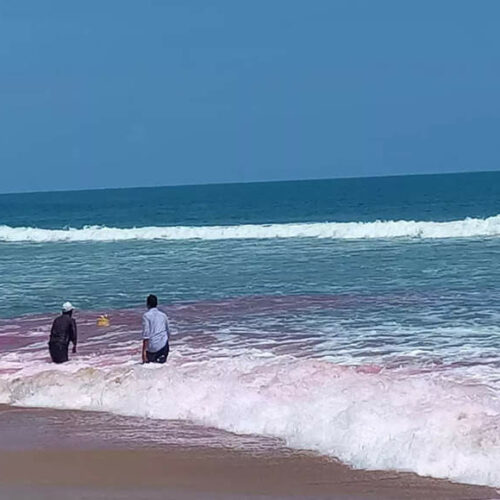The research was started in the month of March of this year, but the survey was conducted in the month of October. The experts have already identified that rip current is the main cause of drowning deaths. Now, they are focussed on deep research over the rip current and safety measures.
The researchers from ISRO, AU, and NCES have reportedly identified the rip current zones in Rushikonda and also at RK Beach. They would assess the intensity of the rip current and also prepare an alert system to save people from drowning deaths in the rip current zones through Artificial Intelligence as part of the Machine Learning software.
According to sources, ISRO scientists Arun Kumar, and Ramesh Kumar from NCES. Girish and Venkateswarlu from AU are now conducting studies.
Vizag beaches
The rip current is very high during a full moon, morning 10 to 11 AM AND 4 pm to 5 pm in the monsoon seasons. So, the researchers wish to alert the tourists or visitors of the beaches who are now preparing for the alert system.
According to police data, more than 525 persons died from 2006 to 2017. Around 70 people drowned from 2019 to date. More than 200 people have drowned in RK beach in the past two decades. Rushikonda, Yarada, Appikonda and other beaches in second place.
Sources said that the researchers had already set up a video camera at Rushikonda beach by using the Marine Police Tower. The camera would record the intensity of the rip current at different times.
“We would set up an alert system which could alert the lifeguards or marine police or local police. The system would provide information to the local police about the persons who are drowning. This study and the alert system would be set up on other beaches such as RK beach, Yarada, Bheemili, and other beaches in the city once the Rushikonda beach project results would be a success,’ the head of the department of AU Meteorology and Oceanography CV Naidu told TOI.
One of the research students Venkateswarlu told TOI that rip current would be high in the present North East Monsoon. As per their studies, rip currents form as per the studies in Rushikonda and RK beach. “We started a survey with the Idegionous Nemo drifter which would give data on PH, Water quality, rip current velocity, sea surface temperature, and others in the drifter. We sent a drifter 300 meters into the sea and recorded the data,” he said.
He further added that they conducted the survey last week with an instrument- directional wave and tide recorder, deployed into the sea. The equipment is still in the sea and it will be retrieved by Thursday. The equipment would provide wave and tide parameters.
According to sources, a rip current will form on the shore and it would travel offshore. The researcher can identify the movement of a rip current. They would record one week’s data and process the data with the help of the ISRO’s unit at Ahmedabad. They would corroborate the feed of the video camera at Rushikonda beach also.
The ISRO scientist Arun Kumar said that rip current can form at any place. Tide, wave, and bathymetry depend on only RIP current. They have been identified as rip current zones through drifter. Rip current is not visible “ Wave will not break in the rip current area. Where the foam is not developed at the wave breakpoint there will be rip current. The survey is over and we will deploy instruments into the sea every month and the survey will be conducted again in January,” he said.
Sources said that the researchers of ISRO, AU NCES have identified the rip current zones at Sai Priya Resort side and also the Kali Mata temple area on the RK beach. “Now, we would suggest alert boards about rip current which will go perpendicular. Our advice to the people who are trapped in the rip current is to shift parallel and swim towards the right and left side and should not swim against the rip current, which would go perpendicular, “ The AU Meteorology and Oceanography department head Naidu said.
Once the study was over, the research team would suggest the local administration put alert boards and also alert systems would be prepared about the rip current zones.





